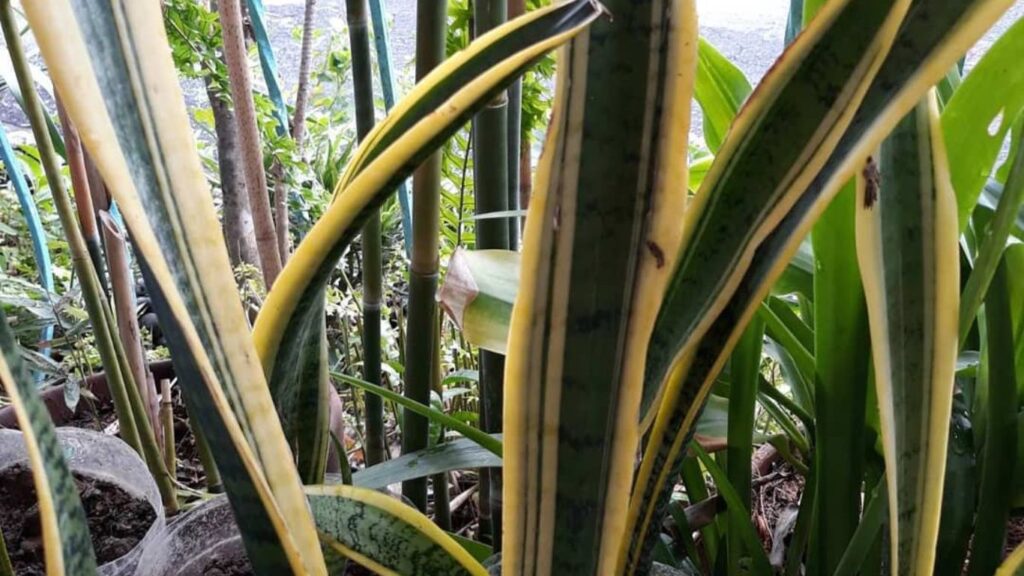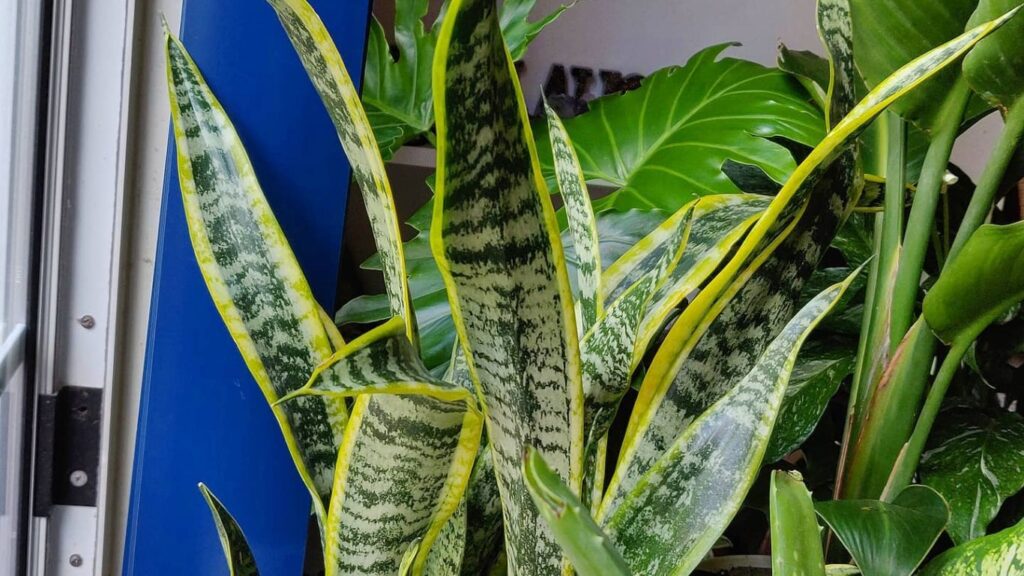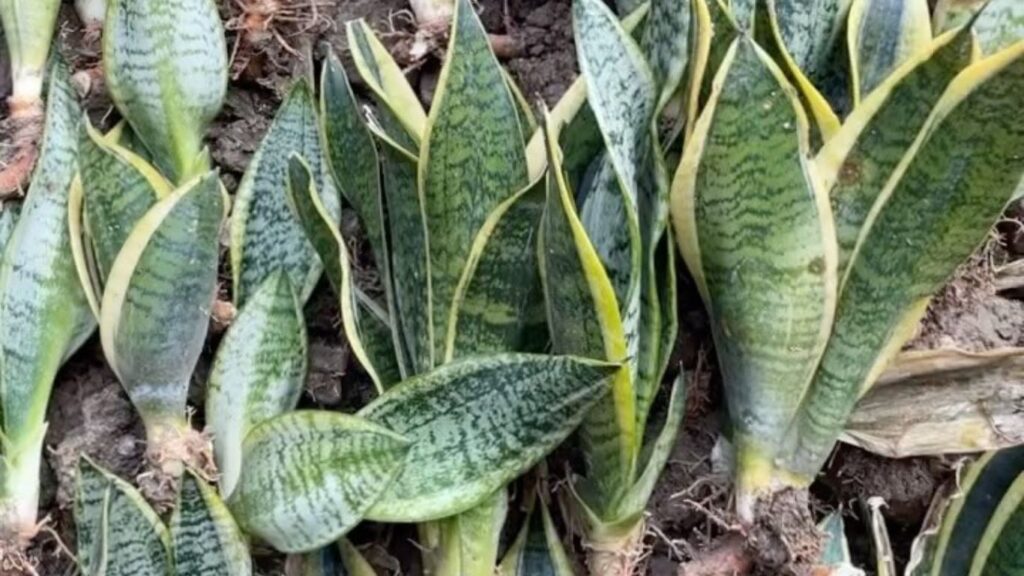The snake plant, also known as mother-in-law’s tongue, Snake plant tips turning brown is a common houseplant, thanks to its low maintenance requirements and attractive appearance.
A member of the succulent family, it has sword-shaped green leaves that are upright, looking almost like artificial leaves.
However, unlike plastic, the snake plant can filter dust and other pollutants from your home’s air and improve your mental and physical health.
Although this is a resilient plant that is relatively easy to care for, you can sometimes notice the tips of the vibrant green leaves turning brown.
It’s nothing to panic, it doesn’t mean your plant is dying! You’re about to find out why.
Causes of Snake Plant Brown Tips.

Snake plant tips turning brown are usually caused by inconsistent watering, too much direct sunlight, or over-fertilization.
Although many plants rebound, extreme cases can be fatal. Regular maintenance checks ensure a thriving snake plant.
The Causes and Solutions For Snake Plant Tips Turning Brown
There are a few possible underlying causes, including quick, cheap solutions.
Lack of Adequate Water Supply
Snake plants generally don’t need a lot of water to survive or thrive. however, they are not completely immune to drying out.
If you leave it without enlisting someone to go on vacation for a long time and don’t water it, or forget to water it for long enough,
Your plant will undoubtedly start to suffer from dehydration. the first place you’ll notice the effects are the tips of the leaves, which may turn brown and brittle.
Remedy
Start more regular watering! During the summer, you’ll want to water whenever the top 3 inches of soil dries out. In the winter, you can water less often,
Just as often as you need to keep your leaves looking healthy. try setting a daily reminder to check the soil’s moisture level. if you are going on vacation, ask someone to stop by for you once a week.
Your Water Intake is High
Snake plant tips turning brown It’s much more common to submerge your snake plant in water than under water. Since your snake plant itself conserves water well,
It doesn’t need to absorb much from the soil. that means that if you keep watering your plants, the soil will stay wet. A damp environment can cause the root system to rot, killing your plant.
Remedy
Stop your plant watering, wait at least ten days for the soil to dry completely. then, you can resume watering according to the schedule described above.
You’re Watering it With Over-Chlorinated Water

Your tap water may contain chemicals, such as chlorine, to kill pathogens and make it safe to drink. however, your snake plant might be more sensitive to chlorine than you.
Depending on where you live and how your municipal water treatment system works, your tap water may have more or less chlorine.
Too much chlorine can also cause Snake plant tips turning brown and brown spots or tips on your snake plant.
Remedy
You can collect rainwater or use distilled water from a bottle or jug to water your plants. You can leave an open container of tap water for 24 hours or longer to allow the chlorine to evaporate.
You Don’t Have The Right Utensils
If you’ve stopped watering but still notice your soil is too wet and your snake plant is developing brown tips, Snake plant tips turning brown your pot may be to blame.
Some potting soil holds more moisture than others. the right pot can make all the difference for a hose plant as sensitive to root rot as for a snake plant.
Not only should it be made of suitable materials, It should be large enough for the root system.
Remedy
Terra cotta pots are considered the best containers for snake plants. terra cotta is a porous material that can absorb excess water from the soil and divert it away from your plant’s root system.
The container in which you plant the seedling should have drainage holes in the bottom. you want a pot that is as wide as your snake plant and a few inches deep.
You Have Wrong Soil in Your Pot

Pots, some soils and potting mixes are made to hold more water than others. This can block drainage and Snake plant tips turning brown, increase the risk of root rot in your snake plant.
If you try to hold off on watering and repotting your snake plant, the problem may be the soil.
Remedy
Find a potting mix formulated to promote drainage, then repot your plant. Here is a complete guide to creating the best soil for snake plants.
You can add a layer of course material like gravel or gravel to the bottom of the pot. These elements allow air and water to pass through more quickly, creating drier conditions for the roots.
It is Hot and Sunny
All plants need sun to grow and the snake plant’s drought-resistant qualities make it perfect for hot environments. Snake plant tips turning brown
However, too much direct sunlight can increase the risk of dehydration, which will cause the tips of your snake plant leaves to turn brown.
The glass trap traps heat, so if your snake plant is directly under or next to a window, It can be subject to quite intense heat, especially in the warmer months.
Remedy
Move your snake plant away from a window that receives a few hours of direct sunlight, especially when the sun is at its strongest in the middle of the day.
Choose a location that gets only morning and afternoon or evening sunlight. if you’re moving your snake plant outside for the summer, gradually move it to a brighter environment to acclimate it.
It’s Too Cold
Snake plant tips turning brown Snake plants are not known for being cold hardy species. Generally, they don’t do well at temperatures below 50 degrees Fahrenheit.
Extremely cold conditions can stress your snake plant and you may see the leaf tips start to turn brown.
Remedy
Snake plants are usually kept indoors, so it shouldn’t be too difficult to keep them at the right temperature.
However, if you bring it outside for the summer, bring it back inside before the temperature gets too low.
Air is Very Dry
Snake plant thrives in moderate moisture levels. 40% humidity is ideal, but they can tolerate slightly less or slightly more.
If the air is too dry, your plant may lose moisture faster than normal. this can cause dehydration and brown leaves and Snake plant tips turning brown.
Remedy
If you live in a particularly dry climate or have dry indoor air, you can use a humidifier to add moisture to the air.
You Have Added Too Much Fertilizer
As with succulents, snake plants are designed to survive in nutrient-poor soil. too much nutrition can damage the root system and cause browning of the leaves.
Snake plant tips turning brown this condition is also known as manure burn.
Remedy
While we generally don’t recommend over-watering your snake plant, you’ll want to flush the soil with water if you’ve over-fertilized your plant.
Move the container to a tub saturate the soil with water, and be careful that the water drains easily.
You Have a Yeast Problem
Too much humidity or moisture can cause mold, mildew and other fungal diseases such as red leaf spot and southern blight.
These fungal infections can directly affect the leaves or attack the root systems, which prevents them from carrying enough nutrients to the leaves.
Either way, the leaves may develop brown spots or the tops of the leaves may turn brown and dry.
Remedy
Remove affected leaves, let the soil dry and adjust the humidity level in your home. if enough is caught, you can use a fungicide to treat the problem.
Consider isolating your plants if you have other houseplants to prevent the spread of infection.
You’ve Got a Pest Problem
Snake plant tips turning brown and Brown spots on your leaves can indicate that pests such as spider mites and mealybugs are feeding on your plants.
If you not carefully treated quickly, pests can cause significant damage to your plant and spread to other plants.
Remedy
Snake plant tips turning brown to prevent pests in damaged areas, try spraying your plants with neem oil. this organic insecticide repels and kills many pests.
If you notice bugs on your plants, you can spray down with a liberal coating of water to submerge and flush the leaves. be sure to check the soil and replace it in another pot if necessary.
Regardless of the cause of the brown spots or tips on your plant, you should start growing fresh, healthy leaves after the problem is resolved.
However, existing brown spots won’t heal, so you may want to trim them off. if leaves are severely damaged, prune to ground level.
You can remove the tip yourself if the rest of the leaf is healthy, but remember that it won’t grow back, so you should be careful to trim it attractively.
Reference:
